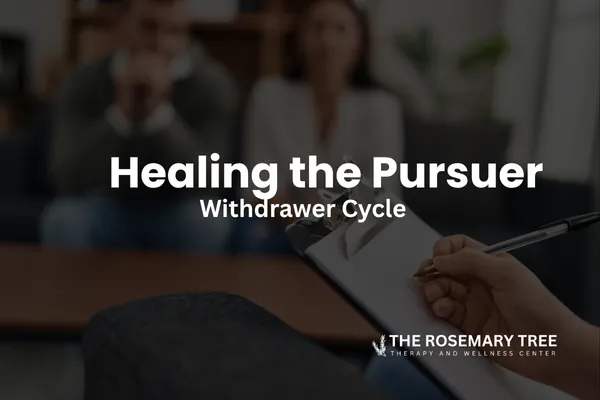
Healing the Pursuer: Withdrawer Cycle
When You Keep Having the Same Fight
After betrayal or deep conflict, many couples find themselves stuck in the same painful pattern. One person reaches out, needing reassurance and answers. The other feels overwhelmed, retreats, and shuts down. The more one pursues, the more the other withdraws.
This cycle is not about stubbornness or lack of effort, it is about fear. The pursuer fears abandonment. The withdrawer fears rejection or failure. Both are trying, in their own way, to feel safe again.
Understanding the Cycle
The pursuer–withdrawer cycle is one of the most common attachment patterns in relationships. It often intensifies after betrayal, when the foundation of safety has been shaken.
The pursuer seeks closeness, clarity, and reassurance. When those needs are not met, emotions escalate. They may talk more, cry, or push for connection, hoping it will stop the pain.
The withdrawer feels attacked or pressured. To avoid making things worse, they shut down, get quiet, or retreat emotionally. Their distance increases the pursuer’s anxiety, restarting the cycle.
Both partners leave the conversation feeling misunderstood and alone.
What’s Really Happening Beneath the Surface
At its core, the pursuer–withdrawer cycle is a nervous system issue, not a communication failure.
The pursuer’s body feels danger in the distance. Their attachment system activates, flooding them with adrenaline and fear. They reach out to restore connection.
The withdrawer’s body feels danger in conflict. Their system interprets emotional intensity as threat, triggering a freeze or flight response. They shut down to survive.
Neither reaction is wrong, they are protective responses learned long before this relationship began. But when both are activated, each person’s safety signals are misread as danger, and connection breaks down.
How to Begin Breaking the Cycle
Healing starts with slowing down. When both partners learn to pause and recognize the pattern instead of reacting from it, safety begins to return.
Here are a few first steps:
Name the Pattern Together
Say it out loud: “We’re in the cycle again.” Naming it takes the blame out of the moment and turns it into shared awareness.Pause Before Reacting
When emotions rise, take a short break. Agree to return to the conversation when both feel calm enough to listen and stay grounded.Validate Each Other’s Fear
The pursuer can say, “I reach for you because I’m scared you’ll leave.” The withdrawer can say, “I pull away because I’m afraid I’ll make it worse.” Speaking fears aloud creates empathy.Rebuild Safety Through Small Gestures
Eye contact, gentle tone, or physical closeness (when welcome) can help signal safety to both nervous systems.Replace Reaction with Curiosity
Instead of assuming bad intent, ask: “What’s happening for you right now?” This opens the door for connection rather than conflict.
The Role of Secure Attachment
Secure attachment helps couples move beyond this cycle. When both partners begin to feel emotionally safe, the nervous system calms, and communication softens.
The pursuer learns they can take a breath without being abandoned.
The withdrawer learns they can stay present without being attacked.
Together, they create balance, a rhythm of approach and space that supports connection instead of fear.
Why Therapy Intensives Are So Effective for This Pattern
The pursuer–withdrawer dynamic cannot always be shifted in short weekly sessions. It takes time, guided dialogue, and consistent safety for both partners to unlearn the cycle.
Our Accelerated Deep-Work Therapy Intensives give couples a focused environment to practice new patterns with professional support.
During an intensive, couples can:
Identify and understand their attachment patterns
Learn co-regulation tools to stay calm during conflict
Practice new communication techniques in real time
Build confidence in staying emotionally connected even when triggered
The extended time allows each partner to experience what safety and understanding truly feel like, not just talk about it.
What Healing the Cycle Feels Like
As the cycle begins to shift, couples notice small but powerful changes:
Conversations last longer without spiraling
One partner’s calm helps the other stay steady
Fear softens into understanding
Both people feel more seen, even during hard moments
These changes build trust, not just in each other, but in the process of healing itself.
Final Thoughts
The pursuer–withdrawer cycle is not a sign your relationship is broken. It is a sign that both of you are trying to feel safe in different ways. When you slow down, listen, and learn to regulate together, the pattern begins to lose its power.
If you are ready to begin breaking this cycle and learning new ways to connect, we would love to help. You can reach out to us here, and our team will connect with you to talk about what this process could look like. There is no pressure, only space for you to begin rebuilding safety and understanding.
